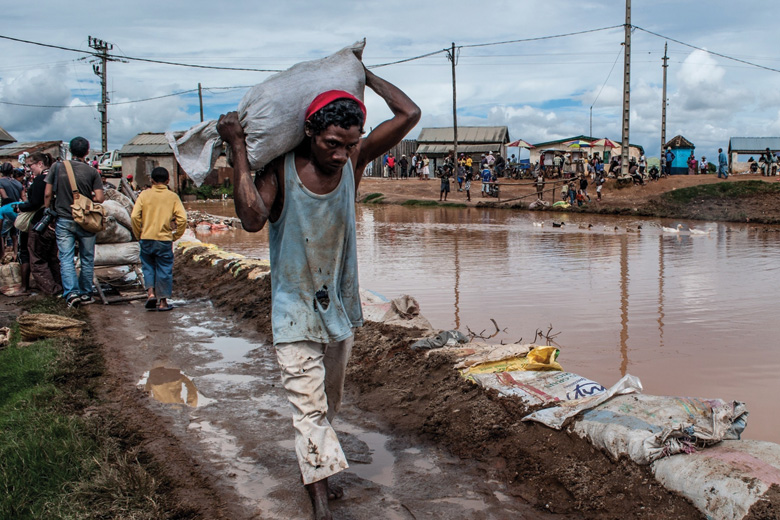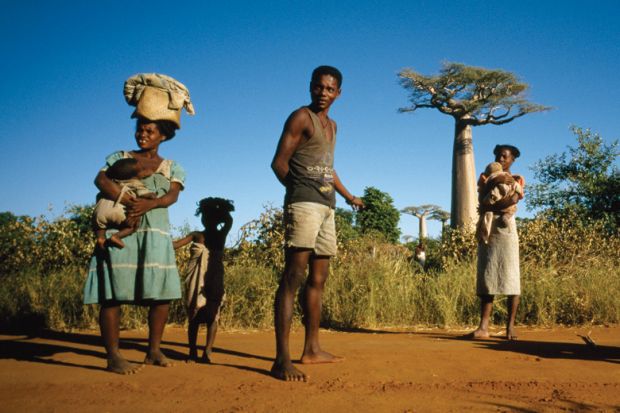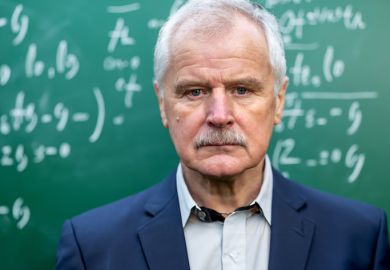The chair of sociology at the University of Antananarivo leans across the table. “I’d really like to talk about Max Weber,” he whispers.
As session chair, I weigh my options. I could say “no” and risk a minor academic diplomatic incident. I could feign an apology, claim it is time for the coffee break and hope he doesn’t remind me later. Instead, I do the tactful and (in hindsight) the right thing: “But of course,” I say.
I wonder how Weber’s anti-positivism could be linked to childhood vaccination rates, school enrolments, the building of latrines or any of the other topics that our sponsor, Unicef, has selected for our discussions. But the 10-minute monologue makes no reference at all to the research issues on the agenda.
My colleagues and I, from the UK, the US and South Africa, feel frustrated. It is December 2014 and we have gathered at a jungle lodge in the highlands of Madagascar with 25 academics and postgraduate students from Antananarivo’s departments of sociology and communication to hash out the methodology for a large-scale research study. However, our research partners’ greater apparent interest in discussing theoretical issues is slowing us down. It is also tough for the interpreters, grappling with three-way simultaneous translation from Malagasy to English, French to English and English to French. The day reaches a low point when I hear through my headphones: “The real problem is situated somewhere between the problematic and the problematisation.”
We feel like prisoners in a jungle of theory. However, over the next few months, I come to realise that the lecture on Weber – and other diversions into Marxist, literary or linguistic theory – are not mere academic posturing. They are – to use development jargon – capacity-building. Unicef has asked our team to build the capacity of Antananarivo staff and students to conduct social research. We know how to design a quantitative and qualitative study, do the data analysis and write the report. But we know little about Madagascar: its culture and turbulent history, or how our Malagasy colleagues regard research. Their priority for the seminar is not to draft survey questionnaires but to build an equal, trusting research partnership.
Ours was an arranged match with Antananarivo, without even a prior blind date. In the open bid process, we worried that our proposal would not make the cut because of our modest French-language skills. My most recent francophone experiences had been at holiday parties at my sister’s home in the Dordogne, where the conversation was about wine, food and plumbing. So when we were awarded the contract, it was time to pull out the maps, bone up on French research phrases and get to know our academic partner in what Unicef was grandly calling the “international research consortium”.
Madagascar’s development challenges are daunting. Frequent coups and political instability have scared away donors and foreign investors. More than 90 per cent of households live on less than $2 (£1.40) a day and over a third are classified as food-insecure. The maternal mortality rate has been rising and child vaccination rates declining. Many households lack access to safe water, and open defecation is common. Only three out of 10 children who begin primary school complete the cycle. In the past year, the country has experienced cyclones and floods on the east coast and drought in the south, as well as an outbreak of the plague and the return of polio.
Unicef has stacks of demographic data, but the statistics do not explain why women give birth at home, why parents take their children out of school, why girls are married off in their teens or why people think river water is purer than tap water. Are the barriers to better health, nutrition, sanitation and education the result of culture or of other factors? Who influences attitudes and behaviours: clan leaders, traditional healers, midwives, mothers-in-law or radio broadcasts? Working with Antananarivo, our task is to design and implement a study of sociocultural determinants.
It is reasonably common knowledge that because Madagascar separated from the continental land mass about 100 million years ago, it boasts animals and plants found nowhere else. Every year, thousands of well-heeled tourists take guided tours through the jungles, cactus forests and deserts. Others come for the beaches, nightlife and the astonishingly cheap French haute cuisine.
But, for a greater number of people, Madagascar is associated primarily with the 2005 computer-animated comedy film about four animals from New York’s Central Park Zoo that are suddenly repatriated to Africa and shipwrecked off the coast of Madagascar. It must be tough to be an academic from a country associated mainly with cartoon lemurs, beaches and baobab trees. How do you talk about political turmoil, poor infrastructure and poverty? This was the context in which our Antananarivo colleagues knew we needed to design the research study.
Madagascar’s first settlers were of Indo-Malay origin. They travelled across the Indian Ocean, settling in the highland regions, where the landscape of rice paddies looks like Thailand or Indonesia. Traders from the Arabian peninsula followed, and peoples of African origin travelled across the Mozambique Channel to settle in coastal regions.
Until the early 19th century, the highlands were a little like medieval Europe. On almost every hill, the local noble, usually from the Merina (Indo-Malay) group, built a fortified position where he ruled over surrounding villages, sending out his retainers to rustle zebu, the humped cattle that are still the mark of wealth in rural society. In the early 19th century, the Merina kings, based in Antananarivo, the capital, extended their rule through alliances and conquest, subduing and often enslaving the African coastal populations. Although the monarchy collapsed in 1897 and France took colonial control, the Merina have remained the most politically and economically powerful group in the country.
Maps and guidebooks show the island neatly divided into 18 ethnic groups, each protecting its own cultural terrain. But ethnicity is actually pretty muddled on the ground. There’s no single criterion for defining an ethnic group. Some are based on racial origins; some are alliances of clans that resisted Merina conquest; and some are classified by economic activity, such as fishing or zebu-herding. Except in isolated rural areas, most communities have an ethnic mix.
Unicef wants to know whether certain attitudes and practices are distinctive to particular ethnic groups, but when we first ask about ethnicity, we face a stone wall. “There are no ethnic groups in Madagascar: we are all Malagasy,” is the standard response.

Knowing that most Malagasy identify by village or community and hold ceremonies to honour their ancestors, we come up with a roundabout way of asking about ethnicity: “Where are the tombs of your ancestors?” However, once again, we are stymied: when the final versions of the questionnaires are translated from French into Malagasy, the question is cut.
The University of Antananarivo campus sits atop one of the city’s many hills, enjoying commanding views across the central highlands. Founded in 1955, it is the country’s leading institution, running doctoral programmes and maintaining links with French and other Western universities. It is also, like Madagascar’s education system in general, woefully underfunded. Academics’ pay is low and their working conditions challenging. Inside the red-brick and concrete buildings (some in disrepair), most classrooms are traditional: long rows of wooden desks facing blackboards. Power cuts are frequent; on the day that we discuss how to phrase questions about handwashing, we can’t wash our own hands because there is no water in the building.
In its post-colonial history, Madagascar has vacillated between dictatorship and freewheeling democracy, between socialism and unbridled capitalism, while maintaining a love-hate relationship with France. The current president’s political party has no representatives in the legislature; when he is not facing impeachment proceedings, he is trying to build coalitions for legislative action. Since the 1970s, the University of Antananarivo has been the focal point for anti-government protests, which does not exactly encourage higher levels of state funding.
Antananarivo is being paid for the Unicef research, and participation in an “international research consortium” also has a certain cachet. But the strongest motivation for the academic faculty and postgraduates is the opportunity to gain experience in fieldwork and to collaborate with foreign researchers. Under our contract, we are supposed to build capacity at the same time as we conduct the research study – although balancing the two tasks while staying on schedule and on budget proves challenging.
Most Antananarivo staff and postgraduate students are Merina, so had the research study been conducted in the Merina-dominated highlands, there would have been few barriers to data collection. However, the three regions selected by Unicef are all on the African-dominated coasts, where the physical and cultural terrain – including the dialect – are quite different.
Most people in the south depend on subsistence agriculture or fishing. The government is resented for taxing and exploiting natural resources without giving back, and opposition to central authority runs deep. Luke Freeman, an anthropologist at University College London who has worked in Madagascar for more than a decade, tells me that the view from the capital is that “parts of the south are ungoverned and parts may be ungovernable”. The army, the police and even health workers venture into the “red zones” at their peril. In this context, it is natural to be suspicious of outsiders asking about living conditions and household income, even if they also ask about vaccinations. Are they really university researchers, or are they gathering data for the tax agency?
To their credit, the Antananarivo researchers work hard to build trust in the communities where they do the interviews, focus group discussions and observations. According to Freeman, research fatigue is common in rural areas: people have seen data collectors come and go, and they have not seen any benefits. Community members will not turn away researchers, but their answers may be “terse, evasive…politely subversive”.
The major barrier to development in Madagascar is poor infrastructure. On the maps, the routes nationales are confidently marked in solid red. But just a few miles outside Antananarivo, vehicles slow down to dodge potholes and mudslides. Travelling in a high-riding Land Cruiser on RN7 – reportedly the best road in the country – it takes us 18 hours of driving time (and two overnight stops) to make the 577-mile (928km) trip from Antananarivo to Toliara, the main port on the south-west coast.
According to the research design, a quantitative study (two questionnaires, with about 1,500 respondents for each) is to be conducted first, to highlight issues to be explored in the subsequent qualitative research. Unfortunately, the eastern floods and southern drought put the project several months behind schedule, and the Antananarivo qualitative research teams go into the field at about the same time as the quantitative research is being conducted, working in different communities. They emerge with hundreds of hours of focus group and interview transcripts and field notes, and it is a formidable task to merge them with the quantitative data.
Ultimately, common sense and pragmatism prevail. We use geographic and economic criteria to classify communities into four types: interior, sub-coastal, coastal and urban. Some interior communities are two days by zebu cart from the main dirt road; including them would lengthen the research and strain the budget. We reduce the long list of variables to be analysed. Our Antananarivo colleagues have a therapeutic 15-minute debate over whether coding – or, indeed, any attempt to organise human experience – is a colonial imposition. And then everyone goes back to work.
Because of its relative isolation and ethnic diversity, Madagascar has been a happy hunting ground for anthropologists. The sheer volume of studies of traditional beliefs and practices makes it tempting to think that they still dominate every sphere of life. Our study indicates that some traditional practices do indeed persist. Many pregnant women still drink a noxious potion called tambavy. After birth, the umbilical cord is buried near the ancestral tomb or cast into the river at a sacred site. Food taboos remain. Traditional forms of marriage are still practised. However, many of the barriers to improving health, sanitation, nutrition and education are practical – distant health facilities, bad schools, untrained teachers and poor infrastructure.
Our Antananarivo colleagues do not deny the role of tradition. They simply say that it is not the only or even the most important factor. They remind us that for many people in Madagascar, survival remains a daily challenge. And when it comes to amending our project’s timeline in the wake of the floods and the drought, their rationale is simple yet evocative: “We should not be asking people questions about nutrition when all they have to eat is cactus.”
David Mould is professor emeritus of media arts and studies at Ohio University in the US. He works as a freelance trainer and consultant in Asia and Africa. His latest book, Postcards from Stanland: Journeys in Central Asia, was published by Ohio University Press in February.
POSTSCRIPT:
Print headline: Theoretical jungle, cultural thicket
Register to continue
Why register?
- Registration is free and only takes a moment
- Once registered, you can read 3 articles a month
- Sign up for our newsletter
Subscribe
Or subscribe for unlimited access to:
- Unlimited access to news, views, insights & reviews
- Digital editions
- Digital access to THE’s university and college rankings analysis
Already registered or a current subscriber? Login




